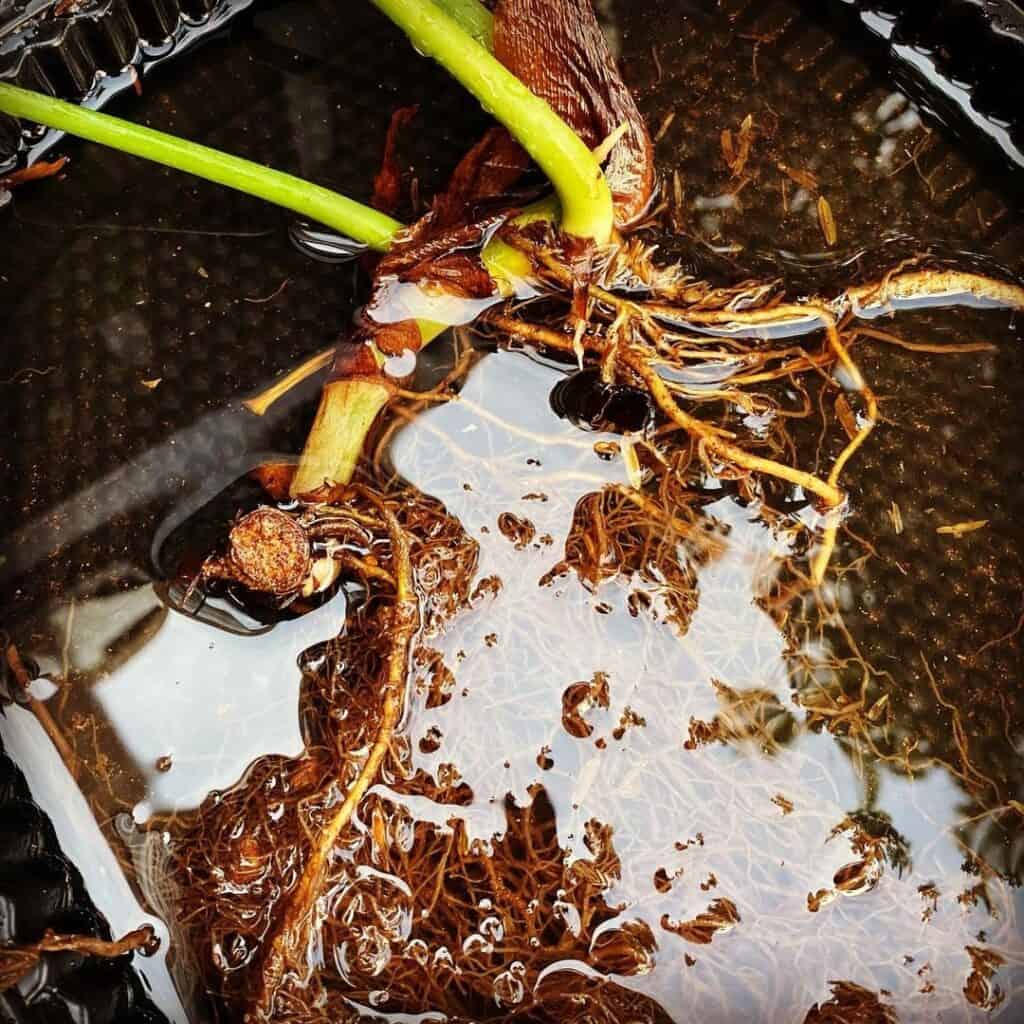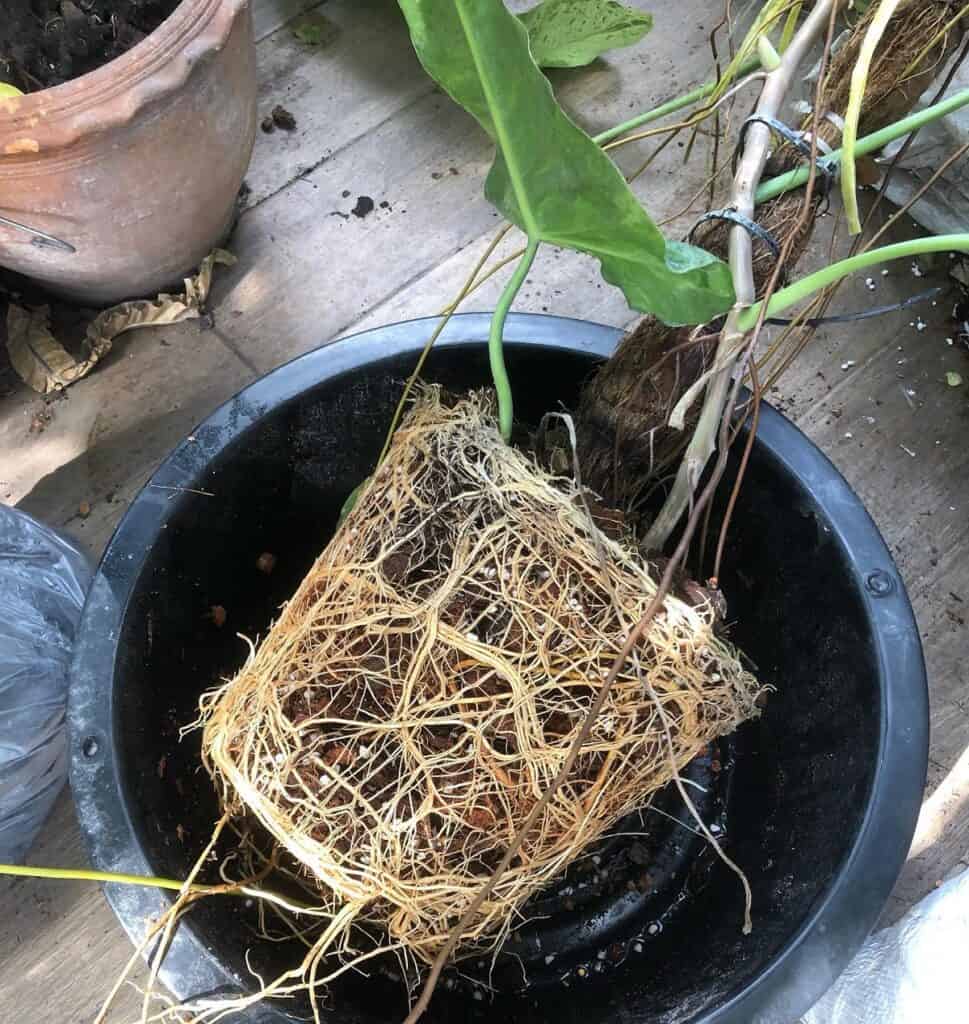Philodendron root rot is a serious problem for many gardeners and houseplant owners. It is important to understand the signs of this disease, how it is caused, and what solutions are available.

The first sign of Philodendron root rot is wilting and yellowing of the leaves. The leaves of the plant will be droopy and discolored, and the stems will become soft and easily break off. If the root rot is left untreated, the plant will eventually die.
Root rot is caused by a fungus that lives in soil that is overly wet or has poor drainage. The fungus will slowly spread throughout the plant’s roots, slowly killing the root system. In order to prevent root rot, it is important to keep the soil of your Philodendron plant well drained and to ensure that the soil is not overly wet.
Contents
What Is Philodendron Root Rot?
Philodendron root rot is a fungal disease that affects the roots of philodendrons, a popular houseplant. It is caused by a fungus known as Phytophthora, which can survive in soil and water for long periods of time. The fungus infects the roots of the plant, causing them to become soft and mushy, and eventually die. Root rot can spread quickly, and can ultimately cause the death of the plant if not treated.
Signs Of Philodendron Root Rot
Identifying the signs of root rot is important in order to take action and save the plant.
The first sign of root rot is the yellowing or browning of leaves. This occurs because the roots are unable to absorb enough water and nutrients for the plant, leading to deficiencies. Other signs include wilting of leaves, stunted growth, and black spots on the leaves. The plant may also seem overly dry, even with regular watering.
In more advanced cases of root rot, the leaves may start to fall off, the stems may become brittle, and the roots may turn black and mushy. The fungus may also start to form a white, cottony substance on the roots. If the root rot is left unchecked, the plant may eventually die.
Causes Of Philodendron Root Rot
1. Overwatering
Overwatering is a common cause of root rot in philodendron plants. When plants are overwatered, the soil can become oversaturated with water, which can cause the roots to become waterlogged. This can lead to anaerobic conditions, where the roots are deprived of oxygen, which can make them susceptible to fungal infections.
2. Poor drainage
Poor drainage is another common cause of root rot in philodendron plants. If the soil is not draining properly, the roots can become waterlogged and the plant can become susceptible to fungal infections. Poor drainage can also lead to an accumulation of salts in the soil, which can further damage the roots.
3. Overfertilization
Overfertilization can also lead to root rot in philodendron plants. If the plant is fertilized too frequently, the salts from the fertilizer can accumulate in the soil and damage the roots.
4. Too little air circulation
Too little air circulation can also lead to root rot, as the plant needs air to help prevent fungal infections and keep the roots healthy.
How To Diagnose Philodendron Root Rot

Diagnosing Philodendron root rot is key to properly treating the condition. Initial signs of root rot can be difficult to spot, as the symptoms are often subtle. However, as the disease progresses, more obvious signs will start to appear.
First, inspect the plant’s roots. Healthy roots are white or cream in color and firm to the touch. If the roots are dark or mushy, and easily pulled away from the stem, it is likely that the plant is suffering from root rot. Other warning signs include wilting and yellowing leaves and an overall lack of vigor.
Another way to diagnose root rot is to gently remove the plant from its pot. If the soil is soggy and holds together when squeezed, this is a possible sign of root rot. The plant’s roots may also appear black and slimy, and the soil may have an unpleasant odor.
Suggested Reading:
How To Grow Philodendron In Water
Treating Philodendron Root Rot
Treating Philodendron root rot can be a tricky process, but it is possible. The first step is to remove the plant from the soil and inspect it for signs of root rot. If any of the roots look brown, mushy, or have a foul odor, then it is likely that root rot is present. Once the affected roots have been identified, they should be trimmed away. It is important to make sure to remove all of the affected roots, as any remaining rot could spread to healthy parts of the plant.
Once the affected roots have been removed, the plant should be repotted in fresh soil. This should be done carefully, as the plant may be fragile and could be further damaged if not handled properly. Additionally, the new soil should be well-draining and free of any disease-causing agents.
After repotting, the Philodendron should be watered carefully. Overwatering can cause further root rot, so it is important to only water the plant when the top inch of the soil is dry. Additionally, it is important to avoid overfertilizing the plant, as this can also lead to root rot.
If you have multiple plants, keep them separate. This will help prevent the spread of root rot from one plant to another.
Finally, the plant should be monitored for further signs of root rot. If any of these signs appear, the plant should be immediately treated with an appropriate fungicide. However, it is important to note that fungicides may not be effective in all cases, so it is best to seek professional advice if the root rot persists.
Solutions For Preventing Philodendron Root Rot
The best way to prevent Philodendron root rot is to ensure that the plant is given the proper growing conditions from the start. The following are some steps to take to ensure that your Philodendron stays healthy and free from root rot.
First, make sure to choose a potting mix that is well-drained. Avoid using soil that holds too much water or is too dense, as this can cause root rot. A soil mix that is composed of equal parts peat moss and perlite is a good choice.
Second, when watering your Philodendron, it is important to avoid overwatering. The soil should be allowed to dry out in between watering. If the soil remains wet for too long, it can cause root rot.
Third, it is important to ensure that the soil has adequate aeration. To achieve this, add some coarse material such as perlite or gravel to the soil. This will help to keep the oxygen levels high and prevent the soil from becoming too compact.

Fourth, be sure to provide adequate drainage for your Philodendron. Drill a few holes in the bottom of the pot to allow excess water to drain off. This will help to ensure that the roots are not sitting in standing water for too long.
Next, make sure that your Philodendron is receiving enough light. Place it in a location that gets bright, indirect light and avoid direct sunlight as it can burn the leaves.
Finally, be sure to keep an eye on the temperature and humidity levels in the room where your Philodendron is located. The soil should be kept slightly moist and the temperature should be between 65 and 85 degrees Fahrenheit. Too much moisture or too low of temperatures can cause root rot.
By following these steps, you can help to ensure that your Philodendron stays healthy and free from root rot.
Conclusion
In conclusion, Philodendron root rot is an unfortunate condition that can be caused by a number of factors, including overwatering, poor drainage, and soil that is not well aerated. It is important to recognize the signs of root rot and act quickly to address the problem.
Taking preventative measures such as selecting well-draining soil, providing adequate aeration, and avoiding overwatering can help to prevent root rot from occurring in the first place. If your beloved Philodendron does suffer from root rot, there are treatments available that can help to restore it to health. With proper care and attention, you can ensure your Philodendron will flourish for many years to come.
